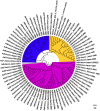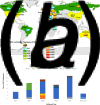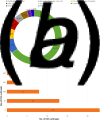Virology and epidemiology analyses of global adenovirus-associated conjunctivitis outbreaks, 1953-2013
- PMID: 26732024
- PMCID: PMC9150610
- DOI: 10.1017/S0950268815003246
Virology and epidemiology analyses of global adenovirus-associated conjunctivitis outbreaks, 1953-2013
Abstract
This study aimed to compare the virology and epidemiology of epidemic keratoconjunctivitis (EKC), pharyngoconjunctival fever (PCF) and acute haemorrhagic conjunctivitis (AHC) outbreaks worldwide caused by the human adenovirus (HAdV) from 1953 to 2013. Eighty-three hexon sequences from 76 conjunctivitis outbreaks were analysed and subtyped using Mega 5.05, Clustal X and SimPlot software. Epidemiology was performed for the area, age and seasonal distribution. A phylogenetic analysis indicated that all the isolates could be divided into three subgenetic lineages, without a common ancestor. The major causes of the outbreaks were Ad8, Ad7 and Ad2 co-infection with enterovirus 70 (EV70) in EKC, PCF and AHC, respectively. The epidemiological findings suggested that EKC and AHC were circulating predominantly in Asia during the early winter and spring, whereas PCF was circulating mainly in China, Australia and the United States during the summer. This study suggests that EKC, AHC and PCF outbreaks have different circulating patterns throughout the world and are caused by different adenovirus serotypes. A global surveillance system should be established to monitor conjunctivitis outbreaks in the future.
Keywords: Adenovirus; conjunctivitis; ocular infection; outbreak; virology.
Figures





Similar articles
-
Novel human adenovirus causing nosocomial epidemic keratoconjunctivitis.J Clin Microbiol. 2008 Jun;46(6):2002-8. doi: 10.1128/JCM.01835-07. Epub 2008 Apr 2. J Clin Microbiol. 2008. PMID: 18385435 Free PMC article.
-
No sequence variation in part of the hexon and the fibre genes of adenovirus 8 isolated from patients with conjunctivitis or epidemic keratoconjunctivitis (EKC) in Norway during 1989 to 1996.J Clin Pathol. 2001 Jul;54(7):558-61. doi: 10.1136/jcp.54.7.558. J Clin Pathol. 2001. PMID: 11429431 Free PMC article.
-
Molecular epidemiology of circulating human adenovirus types in acute conjunctivitis cases in Chandigarh, North India.Indian J Med Microbiol. 2018 Jan-Mar;36(1):113-115. doi: 10.4103/ijmm.IJMM_17_258. Indian J Med Microbiol. 2018. PMID: 29735838
-
A twenty-one year surveillance of adenoviral conjunctivitis in Sapporo, Japan.Int Ophthalmol Clin. 2002 Winter;42(1):49-54. doi: 10.1097/00004397-200201000-00008. Int Ophthalmol Clin. 2002. PMID: 12189615 Review.
-
Human adenovirus type 8: the major agent of epidemic keratoconjunctivitis (EKC).J Clin Virol. 2014 Dec;61(4):477-86. doi: 10.1016/j.jcv.2014.10.015. Epub 2014 Nov 4. J Clin Virol. 2014. PMID: 25464969 Review.
Cited by
-
Epidemic Keratoconjunctivitis in India: Trend Analysis and Implications for Viral Outbreaks.Indian J Ophthalmol. 2020 May;68(5):732-736. doi: 10.4103/ijo.IJO_626_20. Indian J Ophthalmol. 2020. PMID: 32317436 Free PMC article.
-
Clinical Features and Epidemiological Insights of Acute Epidemic Conjunctivitis: A Multicentric Cross-Sectional Study in North Central India.Rom J Ophthalmol. 2024 Oct-Dec;68(4):372-378. doi: 10.22336/rjo.2024.68. Rom J Ophthalmol. 2024. PMID: 39936060 Free PMC article.
-
Seroprevalence of Neutralizing Antibodies to Human Adenovirus Type 4 and 7 in Healthy Populations From Southern China.Front Microbiol. 2018 Dec 10;9:3040. doi: 10.3389/fmicb.2018.03040. eCollection 2018. Front Microbiol. 2018. PMID: 30619131 Free PMC article.
-
Etiological Study of Acute Conjunctivitis Caused by Human Adenovirus in Shanxi Province, China, between 2016 and 2019.Microbiol Spectr. 2023 Aug 17;11(4):e0015923. doi: 10.1128/spectrum.00159-23. Epub 2023 Jul 24. Microbiol Spectr. 2023. PMID: 37486235 Free PMC article.
-
Pathogenesis and management of adenoviral keratoconjunctivitis.Infect Drug Resist. 2018 Jul 17;11:981-993. doi: 10.2147/IDR.S162669. eCollection 2018. Infect Drug Resist. 2018. PMID: 30046247 Free PMC article. Review.
References
-
- Rowe WP, et al. Isolation of a cytopathogenic agent from human adenoids undergoing spontaneous degeneration in tissue culture. Proceedings of the Society for Experimental Biology and Medicine 1953; 84: 570–573. - PubMed
-
- Lenaerts L, et al. Clinical features and treatment of adenovirus infections. Reviews in Medical Virology 2008; 18: 357–374. - PubMed
-
- Lynch JP 3rd, et al. Adenovirus. Seminars in Respiratory and Critical Care Medicine 2011; 32: 494–511. - PubMed
Publication types
MeSH terms
Substances
LinkOut - more resources
Full Text Sources
Other Literature Sources

